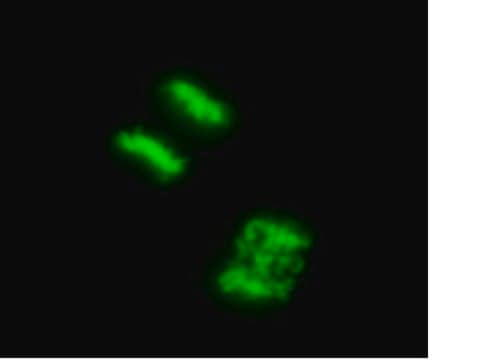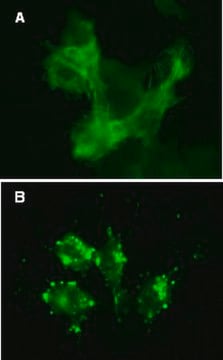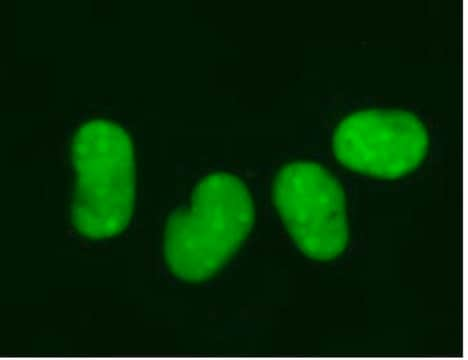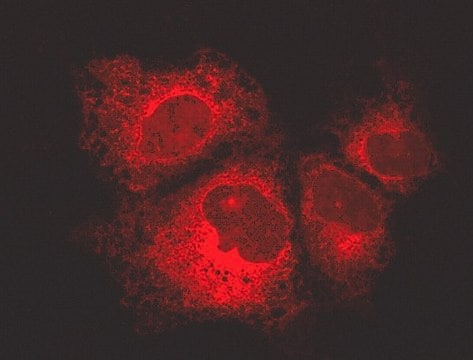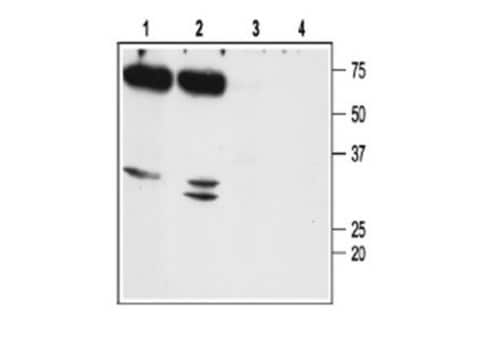推薦產品
一般說明
Read our application note in Nature Methods!
http://www.nature.com/app_notes/nmeth/2012/121007/pdf/an8620.pdf
(Click Here!)
Learn more about the advantages of our LentiBrite Lentiviral Biosensors! Click Here
Biosensors can be used to detect the presence/absence of a particular protein as well as the subcellular location of that protein within the live state of a cell. Fluorescent tags are often desired as a means to visualize the protein of interest within a cell by either fluorescent microscopy or time-lapse video capture. Visualizing live cells without disruption allows researchers to observe cellular conditions in real time.
Lentiviral vector systems are a popular research tool used to introduce gene products into cells. Lentiviral transfection has advantages over non-viral methods such as chemical-based transfection including higher-efficiency transfection of dividing and non-dividing cells, long-term stable expression of the transgene, and low immunogenicity.
EMD Millipore is introducing LentiBrite Lentiviral Biosensors, a new suite of pre-packaged lentiviral particles encoding important and foundational proteins of autophagy, apoptosis, and cell structure for visualization under different cell/disease states in live cell and in vitro analysis.
EMD Millipore’s LentiBrite GFP-α-tubulin lentiviral particles provide bright fluorescence and precise localization to enable live cell analysis of microtubule dynamics in difficult-to-transfect cell types.
http://www.nature.com/app_notes/nmeth/2012/121007/pdf/an8620.pdf
(Click Here!)
Learn more about the advantages of our LentiBrite Lentiviral Biosensors! Click Here
Biosensors can be used to detect the presence/absence of a particular protein as well as the subcellular location of that protein within the live state of a cell. Fluorescent tags are often desired as a means to visualize the protein of interest within a cell by either fluorescent microscopy or time-lapse video capture. Visualizing live cells without disruption allows researchers to observe cellular conditions in real time.
Lentiviral vector systems are a popular research tool used to introduce gene products into cells. Lentiviral transfection has advantages over non-viral methods such as chemical-based transfection including higher-efficiency transfection of dividing and non-dividing cells, long-term stable expression of the transgene, and low immunogenicity.
EMD Millipore is introducing LentiBrite Lentiviral Biosensors, a new suite of pre-packaged lentiviral particles encoding important and foundational proteins of autophagy, apoptosis, and cell structure for visualization under different cell/disease states in live cell and in vitro analysis.
- Pre-packaged, fluorescently-tagged with GFP & RFP
- Higher efficiency transfection as compared to traditional chemical-based and other non-viral-based transfection methods
- Ability to transfect dividing, non-dividing, and difficult-to-transfect cell types, such as primary cells or stem cells
- Non-disruptive towards cellular function
EMD Millipore’s LentiBrite GFP-α-tubulin lentiviral particles provide bright fluorescence and precise localization to enable live cell analysis of microtubule dynamics in difficult-to-transfect cell types.
Microtubules are dynamic cytoskeletal filaments composed of tubulin subunits that play central roles during mitosis (in the mitotic spindle) and during interphase as a scaffold for directed kinesin- and dynein-mediated movement of cellular cargo. Several families of microtubule-binding agents, such as taxanes and vinca alkaloids, disrupt microtubule dynamics and cause cell death, and are clinically effective chemotherapeutic agents. Imaging of microtubule dynamics in live cells expressing tubulin tagged with fluorescent proteins has contributed greatly to our understanding of microtubule-binding agents.
EMD Millipore’s LentiBrite GFP-α-tubulin lentiviral particles provide bright fluorescence and precise localization to enable live cell analysis of microtubule dynamics in difficult-to-transfect cell types.
EMD Millipore’s LentiBrite GFP-α-tubulin lentiviral particles provide bright fluorescence and precise localization to enable live cell analysis of microtubule dynamics in difficult-to-transfect cell types.
應用
Fluorescence microscopy imaging:
HT-1080 cells were plated in a chamber slide and transduced with lentiviral particles at an MOI of 20 for 24 hours. After media replacement and 48 hours further incubation, cells were fixed with formaldehyde and mounted. Image was obtained by oil immersion wide-field fluorescence microscopy. The GFP-tubulin displays predominantly cytoplasmic, fibrillar signal. Able to visualize mitotic cells with visible spindle apparatus formation.
Immunocytochemistry Comparison and Modulator Analysis:
(See Figure 2 in datasheet)
Similar to Figure 1, HT-1080 cells were plated in a chamber slide and transduced with lentiviral particles at an MOI of 20 for 24 hours. After media replacement and 48 hours further incubation, cells were either left untreated, incubated for 4 hours with 1 µM paclitaxel (PTX, a microtubule stabilizer), or incubated for 4 hours with 25 µM nocodazole (NZL, a microtubule depolymerization agent). PTX-treated cells become rounded and display the formation of tubulin “bundles”, while NZL eliminates fibrillar tubulin structure. Immunocytochemical staining (red) of the same fields of view with a monoclonal antibody against α-tubulin reveals similar expression patterns to the GFP-protein (green).
Hard-to-transfect Cell Types:
(See Figure 3 in datasheet)
Primary cell types HUVEC or HuMSC were plated in chamber slides and transduced with lentiviral particles at an MOI of 40 for 24 hours. Cells were either left untreated, or treated for 4 hours with the microtubule stabilizer paclitaxel, at 1 µM concentration.
For optimal fluorescent visualization, it is recommended to analyze the target expression level within 24-48 hrs after transfection/infection for optimal live cell analysis, as fluorescent intensity may dim over time, especially in difficult-to-transfect cell lines. Infected cells may be frozen down after successful transfection/infection and thawed in culture to retain positive fluorescent expression beyond 24-48 hrs. Length and intensity of fluorescent expression varies between cell lines. Higher MOIs may be required for difficult-to-transfect cell lines.
HT-1080 cells were plated in a chamber slide and transduced with lentiviral particles at an MOI of 20 for 24 hours. After media replacement and 48 hours further incubation, cells were fixed with formaldehyde and mounted. Image was obtained by oil immersion wide-field fluorescence microscopy. The GFP-tubulin displays predominantly cytoplasmic, fibrillar signal. Able to visualize mitotic cells with visible spindle apparatus formation.
Immunocytochemistry Comparison and Modulator Analysis:
(See Figure 2 in datasheet)
Similar to Figure 1, HT-1080 cells were plated in a chamber slide and transduced with lentiviral particles at an MOI of 20 for 24 hours. After media replacement and 48 hours further incubation, cells were either left untreated, incubated for 4 hours with 1 µM paclitaxel (PTX, a microtubule stabilizer), or incubated for 4 hours with 25 µM nocodazole (NZL, a microtubule depolymerization agent). PTX-treated cells become rounded and display the formation of tubulin “bundles”, while NZL eliminates fibrillar tubulin structure. Immunocytochemical staining (red) of the same fields of view with a monoclonal antibody against α-tubulin reveals similar expression patterns to the GFP-protein (green).
Hard-to-transfect Cell Types:
(See Figure 3 in datasheet)
Primary cell types HUVEC or HuMSC were plated in chamber slides and transduced with lentiviral particles at an MOI of 40 for 24 hours. Cells were either left untreated, or treated for 4 hours with the microtubule stabilizer paclitaxel, at 1 µM concentration.
For optimal fluorescent visualization, it is recommended to analyze the target expression level within 24-48 hrs after transfection/infection for optimal live cell analysis, as fluorescent intensity may dim over time, especially in difficult-to-transfect cell lines. Infected cells may be frozen down after successful transfection/infection and thawed in culture to retain positive fluorescent expression beyond 24-48 hrs. Length and intensity of fluorescent expression varies between cell lines. Higher MOIs may be required for difficult-to-transfect cell lines.
Research Category
Cell Structure
Cell Structure
Research Sub Category
Cytoskeleton
Cytoskeleton
成分
TagGFP2-Tubulin Lentivirus:
One vial containing 25 µL of lentiviral particles at a minimum of 3 x 10E8 infectious units (IFU) per mL.
For lot-specific titer information, please see lot specific “Viral Titer” in the product specifications of the datasheet.
Promoter
EF-1 (Elongation Factor-1)
Multiplicty of Infection (MOI)
MOI = Ratio of # of infectious lentiviral particles (IFU) to # of cells being infected.
Typical MOI values for high transduction efficiency and signal intensity are in the range of 20-40. For this target, some cell types may require lower MOIs (e.g., HT-1080, human umbilical vein endothelial cells (HUVEC)), while others may require higher MOIs (e.g., HeLa, human mesenchymal stem cells (HuMSC), U2OS).
NOTE: MOI should be titrated and optimized by the end user for each cell type and lentiviral target to achieve desired transduction efficiency and signal intensity.
One vial containing 25 µL of lentiviral particles at a minimum of 3 x 10E8 infectious units (IFU) per mL.
For lot-specific titer information, please see lot specific “Viral Titer” in the product specifications of the datasheet.
Promoter
EF-1 (Elongation Factor-1)
Multiplicty of Infection (MOI)
MOI = Ratio of # of infectious lentiviral particles (IFU) to # of cells being infected.
Typical MOI values for high transduction efficiency and signal intensity are in the range of 20-40. For this target, some cell types may require lower MOIs (e.g., HT-1080, human umbilical vein endothelial cells (HUVEC)), while others may require higher MOIs (e.g., HeLa, human mesenchymal stem cells (HuMSC), U2OS).
NOTE: MOI should be titrated and optimized by the end user for each cell type and lentiviral target to achieve desired transduction efficiency and signal intensity.
品質
Evaluated by transduction of HT-1080 cells and fluorescent imaging performed for assessment of transduction efficiency.
外觀
PEG precipitation
儲存和穩定性
Storage and Handling
Lentivirus is stable for at least 4 months from date of receipt when stored at -80°C. After first thaw, place immediately on ice and freeze in working aliquots at -80°C. Frozen aliquots may be stored for at least 2 months. Further freeze/thaws may result in decreased virus titer and transduction efficiency.
IMPORTANT SAFETY NOTE
Replication-defective lentiviral vectors, such as the 3rd Generation vector provided in this product, are not known to cause any diseases in humans or animals. However, lentiviruses can integrate into the host cell genome and thus pose some risk of insertional mutagenesis. Material is a Risk Group 2 and should be handled under BSL2 controls. A detailed discussion of biosafety of lentiviral vectors is provided in Pauwels, K. et al. (2009). State-of-the-art lentiviral vectors for research use: Risk assessment and biosafety recommendations. Curr. Gene Ther. 9: 459-474.
Lentivirus is stable for at least 4 months from date of receipt when stored at -80°C. After first thaw, place immediately on ice and freeze in working aliquots at -80°C. Frozen aliquots may be stored for at least 2 months. Further freeze/thaws may result in decreased virus titer and transduction efficiency.
IMPORTANT SAFETY NOTE
Replication-defective lentiviral vectors, such as the 3rd Generation vector provided in this product, are not known to cause any diseases in humans or animals. However, lentiviruses can integrate into the host cell genome and thus pose some risk of insertional mutagenesis. Material is a Risk Group 2 and should be handled under BSL2 controls. A detailed discussion of biosafety of lentiviral vectors is provided in Pauwels, K. et al. (2009). State-of-the-art lentiviral vectors for research use: Risk assessment and biosafety recommendations. Curr. Gene Ther. 9: 459-474.
法律資訊
CHEMICON is a registered trademark of Merck KGaA, Darmstadt, Germany
儲存類別代碼
10 - Combustible liquids
水污染物質分類(WGK)
WGK 2
分析證明 (COA)
輸入產品批次/批號來搜索 分析證明 (COA)。在產品’s標籤上找到批次和批號,寫有 ‘Lot’或‘Batch’.。
文章
包含β-肌动蛋白、α-微管蛋白和波形蛋白用于细胞骨架结果蛋白活细胞分析的高滴度慢病毒颗粒。
High titer lentiviral particles including beta-actin, alpha-tubulin and vimentin used for live cell analysis of cytoskeleton structure proteins.
相關內容
Fluorescent lentiviral particles encoding important GFP/RFP fusion proteins related to autophagy, apoptosis, and cell structure that enables live cell imaging.
我們的科學家團隊在所有研究領域都有豐富的經驗,包括生命科學、材料科學、化學合成、色譜、分析等.
聯絡技術服務

